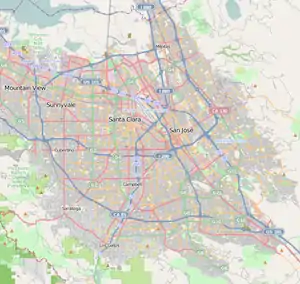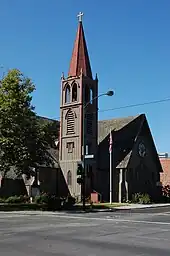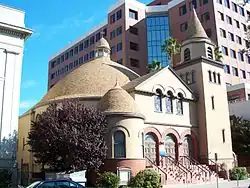St. James Park (San Jose)
St. James Park is a 6.8-acre (2.8 ha) park in downtown San Jose, California. Originally laid out as St. James Square in 1848, local newspapers dubbed the site a park in 1885, shortly after a fountain was installed in the center of the area. In 1933, two men who were accused of kidnapping and murdering Brooke Hart were lynched in St. James Park. Since then, a road and light rail tracks have been added, bisecting the park; it is now a popular gathering spot for the homeless population of San Jose.
| St. James Park | |
|---|---|
 View west towards the old Santa Clara County Courthouse along N 1st St from St. James Park. | |
 | |
| Coordinates | 37.338949°N 121.891203°W |
| Area | 6.8 acres (2.8 ha) |
| Created | 1800s |
| Operated by | Department of Parks, Recreation & Neighborhood Services, City of San Jose |
| Open | daily, sunrise – sunset |
| Public transit access | |
| Website | www |
St. James Square | |
| Built | 1863–1933 |
| NRHP reference No. | 79000546[1] |
| Added to NRHP | November 27, 1979 |
History
St. James Square was mapped in 1848 as part of the official survey of the city by Chester Lyman,[2][3]: 7 but not further developed until after Trinity Episcopal Church was erected next to the square in 1863; the Square was developed in the late 1860s, starting with a fence erected in 1866. William O'Donnell landscaped the park under contract to the city of San Jose.[4]: 3, 8 It was one of three public squares in San Jose at the time, alongside Washington Square (site of present-day San Jose State) and Market Plaza (now Plaza de César Chávez); O'Donnell was responsible for all three.[4]: 8 [5] Under O'Donnell's plan, the landscaping effort was in planting hundreds of trees to provide shade, a rarity in downtown San Jose at the time.[4]: 10 At the time, no paths were known to exist, based on the earliest photograph of the park, dating to 1870.[3]: 7 Although oral histories indicate that Frederick Law Olmsted was involved in the initial design of the park, his formal participation has not been confirmed.[3]: 5–6 A hole 500 feet (150 m) deep was dug to provide a city well, but without success, and the effort was abandoned in 1879.[6]
One of the first major features was a fountain at the park's center; it was built in 1885 and the area began to be called St. James Park instead of St. James Square at about this time.[4]: 10 According to contemporary photographs, the fountain contained a standing female figure, with water spilling from an urn held over the statue's head.[3]: 8 The fence was removed in 1886.[7] In 1887, Rudolph Ulrich was given a contract to re-landscape all three public squares.[4]: 8 Simultaneously, local merchants advocated for an extension of North Second Street through the park. Ulrich is credited with adding rows of palm trees along North First and Third streets to provide a more formal border between the park and encroaching downtown businesses.[4]: 10 By 1891, formal diagonal and curvilinear paths had been laid through the park, according to contemporary photographs and that year's Sanborn Fire Insurance Map.[3]: 4, 8
President William McKinley visited San Jose on May 13, 1901 en route to San Francisco;[8] plans for his welcome included a giant bouquet of cut flowers 30 feet (9.1 m) tall and 90 feet (27 m) in circumference at the western entrance to St. James Park,[9] billed as the largest bouquet ever made.[10][11] After his assassination in September 1901, citizens of San Jose held a memorial service at St. James Park and began planning a permanent monument.[12][13]

The William McKinley statue was placed on its base in December 1902.[14] On February 21, 1903, the statue was unveiled on the site where the president had spoken to the public during his visit to the city in May 1901. The standing bronze sculpture, mounted on a granite pedestal, was executed by Rupert Schmid at a cost of US$13,500 (equivalent to $440,000 in 2022), paid through private donations.[15] A brass cannon is at the foot of the McKinley monument; it has been the site of vigilante justice, including a 1918 incident in which George Koetzer, a brewery employee, was accused of making pro-German remarks, for which he was tarred and feathered, then chained to the cannon.[16]
The city made its first drawing of the park in 1920,[3]: 4 showing an overhead view of the park's layout. Diagonal paths connect the corners of the park with the central fountain plaza; additional paths cutting east-west and north-south through the center of the park are also present, along with a meandering path connecting all four corners slightly in from the park's perimeter.[17]: 6
The 1885 fountain was demolished in a remodel that occurred under a Works Progress Administration (WPA) project to renovate the park in the 1930s.[4]: 3 Various WPA projects brought a new post office to the park's western edge and restrooms at the northern and southern ends of the park; the restrooms were removed in the 1950s.[4]: 14 During the construction of the post office, Harold Thurmond and John Holmes were lynched in St. James Park for the kidnapping and murder of Brooke Hart in November 1933.[18] Construction materials from the post office were used to storm the city jail where the men were being held; the trees in the park from which the men were hanged (not far from the McKinley memorial) were removed shortly afterward to deter souvenir-seekers.[19][20]
Other memorials within St. James Park honor Henry Morris Naglee (erected 1915 by his daughters)[3]: 10 and Robert F. Kennedy (1970).[21][22] Kennedy had spoken at St. James Park on March 23, 1968 while running for president; he was assassinated later that year.[23][24][25] In 1994, the Memorial Bell for San Jose firefighters was moved to the park from Plaza de César Chávez;[3]: 11 it was subsequently relocated to Old Fire Station 1 in 2001.[26]
Voters narrowly passed an initiative to extend North Second Street through the center of the park in 1952 to accommodate increased traffic,[3]: 11 and the extension was completed in 1955, bisecting it; a later proposal to remove North Second in 1976 failed.[4]: 3, 14–15 A senior center was constructed in 1973 in the northeast quadrant of the park, using modular structures that were intended to be temporary.[3]: 11
The St. James Square Historic District was added to the National Register of Historic Places on November 27, 1979. It encompasses the original St. James Square (now St. James Park) along with several bordering properties.[1]
A replacement fountain was constructed between 1988 and 1990 in the western half of the park, but is presently not functioning. The 1990 fountain is meant to evoke the 1885 fountain but not replicate it.[4]: 3
Location

St. James Park is bounded by East St. James Street (on the north), North Third St (on the east), East St. John St (on the south), and North First St (on the west);[1] it is divided into western and eastern halves by North Second Street. As originally laid out, it measured 1,005 feet (306 m) (east-west between North First and North Third) and 610 feet (190 m) (north-south from East St James to East St John).[3]: 9
It is served by the Saint James Santa Clara Valley Transportation Authority light rail stop; northbound trains stop along the western edge, along North First, and southbound trains stop in the center of the park, along North Second. The light rail lines were completed in 1988.[3]: 11
St. James Square Historic District
The St. James Square Historic District established in 1979 consisted of St. James Park along with nine contributing properties surrounding it.[1]
One of the properties listed as contributing to the Historic District, the Clarence Letcher Garage or Four-Wheel Brake Building at the corner of N 1st and St James, most recently housed the Oasis nightclub until it was shut down in 1996 following the beating death of Jason Cooper;[27] the building was demolished in 2010.[28] Clarence Letcher was a prominent San Jose automobile dealer who was shot and killed by his wife in a murder-suicide that occurred at the Garage on July 3, 1926.[29][30][31]
| No. | Name | Image | Address | Year | Architect |
|---|---|---|---|---|---|
| 1 | Old Courthouse |  |
161 N 1st | 1866 | Levi Goodrich |
| 2 | Post Office |  |
105 N 1st | 1933 | Ralph Wyckoff |
| 3 | Trinity Episcopal Church |  |
81 N 2nd | 1863 | John W. Hammond |
| 4 | Eagles Club | .jpg.webp) |
152 N 3rd | 1900 | — |
| 5 | First Unitarian Church |  |
160 N 3rd | 1891 | G.W. Page |
| 6 | Scottish Rite Temple |  |
196 N 3rd | 1924 | Carl Werner |
| 7 | Sainte Claire Club | .jpg.webp) |
65 E St James | 1893 | A. Page Brown |
| 8 | First Church of Christ Scientist | _-_DSC03828.JPG.webp) |
61 E St James | 1904 | Willis Polk |
| 9 | Letcher Garage | 200 N 1st | 1906 | — |
References
- "National Register Information System – St. James Square (#79000546)". National Register of Historic Places. National Park Service. November 2, 2013.
- Peak, Dana (September 29, 2021). San José Historic Context Statement (Report). San Jose Department of Planning, Building, and Code Enforcement. p. 49. Retrieved October 6, 2022.
- Architectural Resources Group (September 26, 2001). Historical Analysis, St. James Park, San Jose, California (Report). City of San Jose. Retrieved 17 December 2019.
- Historical Evaluation: St. James Park Fountain, 141-199 North Second Street (Report). City of San Jose. November 2, 2015. Retrieved 16 December 2019.
- "San Jose Prospering". The California Farmer. February 3, 1870. Retrieved 16 December 2019.
- "State News in brief". The Weekly Calistogian. September 24, 1879. Retrieved 16 December 2019.
- "San Jose Gossip". Daily Alta California. January 10, 1886. Retrieved 16 December 2019.
The abominable fence around St. James Square has at last given way to the march of improvement. It had become a disgrace to our beautiful city.
- "McKinley Makes Trip to San Jose and To-day Becomes Guest of City". The San Francisco Call. May 14, 1901. Retrieved 16 December 2019.
- "San Jose after outside police". San Francisco Call. May 10, 1901. Retrieved 16 December 2019.
- "Big Bouquet for McKinley". San Francisco Call. March 22, 1901. Retrieved 16 December 2019.
- "Bouquet for the president". San Francisco Call. April 1, 1901. Retrieved 16 December 2019.
- "Services are Held in St. James Park". San Francisco Call. September 20, 1901. Retrieved 16 December 2019.
- "McKinley Memorial Committee". Los Angeles Herald. October 8, 1901. Retrieved 16 December 2019.
- "Veiled McKinley Statue in Place at San Jose". San Francisco Call. December 16, 1902. Retrieved 16 December 2019.
- "Stately McKinley Monument Unveiled with Due Ceremony". San Francisco Call. February 22, 1903. Retrieved 16 December 2019.
- "Tarred and Feathered: Knights of Liberty Get Into Action at San Jose". San Luis Obispo Tribune. May 7, 1918. Retrieved 16 December 2019.
- MPA Design (July 1985). St. James Park Master Plan (Report). City of San Jose. Retrieved 17 December 2019.
- "Mob Lynches Hart Kidnapers | Governor Condones Lynching Party". The Healdsburg Tribune. November 27, 1933. Retrieved 16 December 2019.
- "Souvenir Hunters Strip Tree". Calexico Chronicle. December 2, 1933. Retrieved 16 December 2019.
- "Editorial: What is Liberty?". Coronado Eagle and Journal. December 14, 1933. Retrieved 16 December 2019.
- "Public Art: San Jose downtown". Cultural Affairs - Office of Economic Development, City of San Jose. Archived from the original on November 7, 2014. Retrieved 17 December 2019.
- Herhold, Scott (June 2, 2008). "Memorial for RFK in St. James Park marks happier day". San Jose Mercury News. Retrieved 17 December 2019.
- Pearce, Ralph (February 21, 2018). "Looking Back: Robert F. Kennedy's 1968 Visit to San Jose". San Jose Public Library. Retrieved 17 December 2019.
- Lopez, Steve (June 2, 2018). "Column: 50 years later, the RFK busboy still waits on someone to follow in Kennedy's footsteps". Los Angeles Times. Retrieved 17 December 2019.
- Pizarro, Sal (March 19, 2018). "Pizarro: Robert F. Kennedy's 1968 San Jose speech to be commemorated". San Jose Mercury News. Retrieved 17 December 2019.
- "Quetzalcóatl Sculpture: It is locally loved and ridiculed for literally looking like poop". Atlas Obscura. Retrieved 17 December 2019.
- "San Jose Votes to Close Oasis Nightclub". San Francisco Gate. April 13, 1996. Retrieved 16 December 2019.
- Tucker, Loui (April 16, 2012). "More Photos of San Jose, California". Retrieved 16 December 2019.
- "San Jose auto man wounded; wife suicides". Santa Cruz Evening News. July 3, 1926. Retrieved 20 December 2019.
- "Letcher dies from wife's pistol shots". Santa Cruz Evening News. AP. July 3, 1926. Retrieved 20 December 2019.
- Douglas, Jack (November 1984). "Letcher Garage: Scene of Triumph and Tragedy" (PDF). San Jose Historical Museum Association News. Vol. IV, no. 6. San Jose Historical Museum Association. p. 4. Retrieved 10 September 2020.
External links
- St. James Park, from Visit San Jose
- Carlson, Eric. "St. James Park". Soft Underbelly of San Jose.
- "St. James Park revitalization". City of San Jose.
.tiff.jpg.webp)
.jpg.webp)

